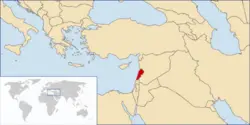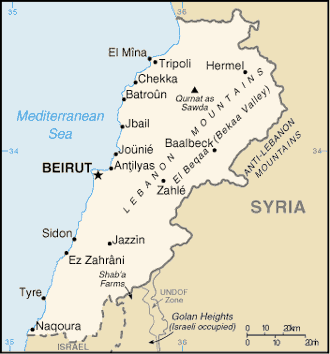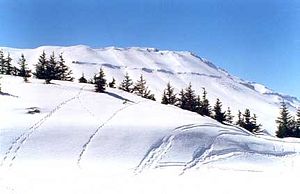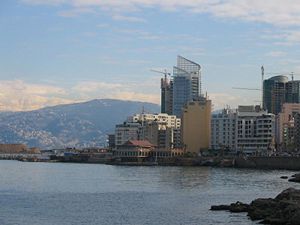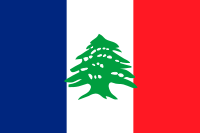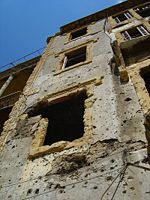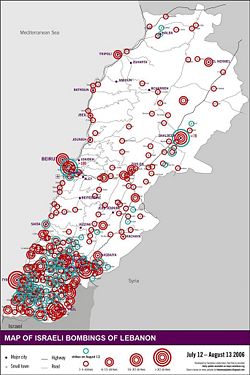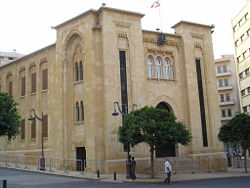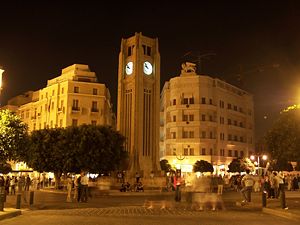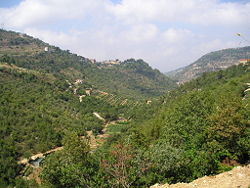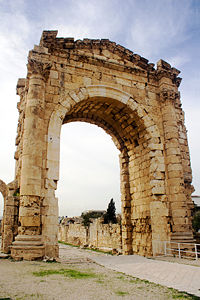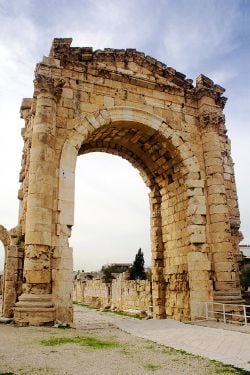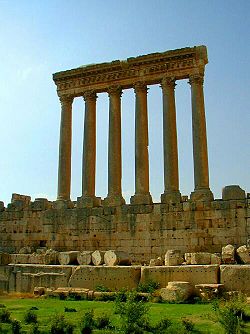Difference between revisions of "Lebanon" - New World Encyclopedia
Mike Butler (talk | contribs) m |
Mike Butler (talk | contribs) |
||
| Line 221: | Line 221: | ||
==Demographics== | ==Demographics== | ||
[[Image:Lebanon-demography.png|thumb|350px|right|Demographics of Lebanon, Data of [[FAO]], year 2005 ; Number of inhabitants in thousands.]] | [[Image:Lebanon-demography.png|thumb|350px|right|Demographics of Lebanon, Data of [[FAO]], year 2005 ; Number of inhabitants in thousands.]] | ||
| − | The number of those inhabiting Lebanon proper was estimated at 3,874,050 in July 2006. About 91 percent of the population of [[Lebanon]] is urban and comprises many different ethnic groups and religions, including numerous [[Christianity|Christian]] and [[Muslim]] sects. | + | The number of those inhabiting Lebanon proper was estimated at 3,874,050 in July 2006. About 91 percent of the population of [[Lebanon]] is urban and comprises many different ethnic groups and religions, including numerous [[Christianity|Christian]] and [[Muslim]] sects. Without accurate figures, it is estimated that there are between five and 15 million people of Lebanese descent spread all over the world, [[Brazil]] being the country with the biggest Lebanese community abroad. [[Argentina]], [[Australia]], [[Canada]], [[Colombia]], [[France]], [[Great Britain]], [[Mexico]], [[Venezuela]] and the [[United States of America|USA]] also have large Lebanese communities. A total of 394,532 [[Palestinian]] refugees have registered in Lebanon with the [[United Nations Relief and Works Agency]]. Life expectancy for the whole population was 72.63 years in 2005. |
===Ethnicity=== | ===Ethnicity=== | ||
| Line 262: | Line 262: | ||
After high school, Lebanese students may choose to study at a university, a college, or a vocational training institute. The number of years to complete each program varies. Lebanon has 41 nationally accredited universities, several of which are internationally recognized | After high school, Lebanese students may choose to study at a university, a college, or a vocational training institute. The number of years to complete each program varies. Lebanon has 41 nationally accredited universities, several of which are internationally recognized | ||
| − | While the Lebanese educational system offers a very high quality and international class of education, the local employment market lacks enough opportunities, thus encouraging many of the young educated to travel abroad. You can find successful Lebanese engineers, doctors, businessmen, etc. practically all over the world. | + | While the Lebanese educational system offers a very high quality and international class of education, the local employment market lacks enough opportunities, thus encouraging many of the young educated to travel abroad. You can find successful Lebanese engineers, doctors, businessmen, etc. practically all over the world. When compared to the rest of the [[Middle East]], Lebanese society as a whole is well educated, and as of 2003, 87.4 percent of the population was literate |
===Class=== | ===Class=== | ||
Money is the most important factor in determining class lines. The middle class lost wealth during the war, and the gap between the rich upper class and the lower class widened. Differences in wealth and status often occur along religious and family lines. | Money is the most important factor in determining class lines. The middle class lost wealth during the war, and the gap between the rich upper class and the lower class widened. Differences in wealth and status often occur along religious and family lines. | ||
| − | |||
==Culture== | ==Culture== | ||
Revision as of 18:33, 22 May 2007
| الجمهورية اللبنانية Al-Jumhūriyyah al-Lubnāniyyah Lebanese Republic | |||||
| |||||
| Motto: Kūllūnā li-l-waṭan, li-l-'ula wa-l-'alam (Arabic) "We are all for the Country, the Sublime and the Flag!" | |||||
| Anthem: Kulluna lil-watan lil 'ula lil-'alam | |||||
| Capital | Beirut 33°54′N 35°32′E | ||||
|---|---|---|---|---|---|
| Largest city | capital | ||||
| Official languages | Arabic | ||||
| Government | Republic | ||||
| - President | Émile Lahoud | ||||
| - Prime Minister | Fouad Siniora | ||||
| Independence | |||||
| - Declared | November 26 1941 | ||||
| - Recognized | November 22 1943 | ||||
| Area | |||||
| - Total | 10,452 km² (166th) 4,035 sq mi | ||||
| - Water (%) | 1.6 | ||||
| Population | |||||
| - July 2007 (estimate) estimate | 3,925,502 | ||||
| - Density | 358/km² 948/sq mi | ||||
| GDP (PPP) | 2005 estimate | ||||
| - Total | $24.42 billion | ||||
| - Per capita | 6,681 | ||||
| HDI (2006) | 0.774 (medium) | ||||
| Currency | Lebanese lira (LL) (LBP)
| ||||
| Time zone | EET (UTC+2) | ||||
| - Summer (DST) | EEST (UTC+3) | ||||
| Internet TLD | .lb | ||||
| Calling code | +961 | ||||
Lebanon (Arabic: لبنان Lubnān), officially the Lebanese Republic (Arabic: الجمهورية اللبنانية), is a small, largely mountainous country in the Middle East, located at the eastern edge of the Mediterranean Sea.
Due to its sectarian diversity, Lebanon follows a special political system, known as confessionalism, meant to distribute power as evenly as possible among different sects.
Until the Lebanese Civil War (1975-1990), the country enjoyed relative calm and prosperity, driven by the tourism, agriculture, and banking sectors of the economy. It was considered the banking capital of the Arab world and was widely known as the "Switzerland of the Middle East" due to its financial power. Lebanon also attracted large numbers of tourists, to the point that the capital Beirut became widely referred to as the "Paris of the Middle East."
Immediately following the end of the war, there were extensive efforts to revive the economy and rebuild national infrastructure. By early 2006, a considerable degree of stability had been achieved throughout much of the country, Beirut's reconstruction was almost complete, and an increasing number of foreign tourists were pouring into Lebanon's resorts.
However, the 2006 Lebanon War brought civilian and military casualties, extensive damage to civilian infrastructure, and massive population displacement. Since September 2006, the Lebanese government has been implementing an early recovery plan aimed at reconstructing property destroyed by Israeli attacks in Beirut, Tyre, and other villages in southern Lebanon.
Geography
The name Lebanon ("Lubnān" in standard Arabic; "Lebnan" or "Lebnèn" in local dialect) is derived from the Semitic root "LBN", which is linked to several closely-related meanings in various languages, such as white and milk. This is regarded as reference to the snow-capped Mount Lebanon. Occurrences of the name have been found in three of the 12 tablets of the Epic of Gilgamesh, and the Bible.[1] The word Lebanon is also mentioned 71 times in the Old Testament.
Lebanon is bordered by the Mediterranean Sea to the west, by Syria to the east and north, and by Israel to the south. The border with the Israeli-occupied Golan Heights in Syria is disputed by Lebanon in a small area called Shebaa Farms, but the border has been demarcated by the United Nations.
Lebanon is a narrow strip of territory approximately 135 miles (215 kilometres) long from north to south and 20 to 55 miles wide from east to west. The country has a total area of 4035 square miles (10,452 square kilometres) making it the 166th largest country in the world, or nearly the size of Connecticut in the United States.
The terrain comprises five ribbon-like topographical areas stretching from North to South. The shoreline, which is 210km long, consists mostly of rocks towards the north, and sand in the south, with some headlands, bays, and offshore islands. The coastal plain is surrounded by sea and mountains, and is rather narrow at two or three kilometers wide. There are the West Mountains, the Beqaa valley, an integral part of Lebanon's agriculture, and the East Mountains. The highest point is Qurnat as Sawda' at 10, 131 feet (3088 meters).
Lebanon has a moderate Mediterranean climate. In coastal areas, winters are generally cool and rainy while summers are hot and humid. In more elevated areas, temperatures usually drop below 32°F (0°C) during the winter with frequent (sometimes heavy) snow. Summers, on the other hand, are warm at 100° F (38°C) and dry. Although most of Lebanon receives a relatively large amount of rainfall annually (compared to its arid surroundings), certain areas in north-eastern Lebanon receive little rainfall because the high peaks of the western mountain front block much of the rain clouds that originate over the Mediterranean Sea.
Although the country is well watered and there are many rivers and streams, there are no navigable rivers, nor is any one river the sole source of irrigation water. The Biqa Valley is watered by two rivers that rise in the watershed near Baalbek: the Orontes flowing north, and the Litani flowing south into the hill region of the southern Biqa Valley, where it makes an abrupt turn to the west in southern Lebanon and is thereafter called the Al Qasmiyah River.
In ancient times, Lebanon housed large forests of the Lebanon cedar, which now serve as the country's national emblem. However, centuries of trading cedar trees, used by ancient mariners for boats, and the absence of any efforts to replant them have depleted Lebanon's once-flourishing cedar forests.
Natural hazards include dust storms and sandstorms. Environmental issues include deforestation, soil erosion, desertification, air pollution in Beirut from vehicular traffic and the burning of industrial wastes, and pollution of coastal waters from raw sewage and oil spills.
Beirut is the capital, largest city, and chief seaport of Lebanon. It is sometimes referred to by its French name, Beyrouth. There are wide-ranging estimates of Beirut's population, from as low as 938,940 people to 1,303,129 people. Other cities are Tyre, an ancient Phoenician city in the south (population 117,100), and Sidon, another ancient city.
History
The earliest known settlements in Lebanon date back to earlier than 5000 b.c.e.. Archaeologists have discovered in Byblos, which is believed to be the oldest continuously inhabited city in the world, remnants of prehistoric huts with crushed limestone floors, primitive weapons, and burial jars which are evidence of the Neolithic and Chalcolithic fishing communities who lived on the shore of the Mediterranean Sea over 7000 years ago.
The Canaanites
Canaanites were original inhabitants of the land of Canaan, an ancient term for a region approximating present-day Israel, the West Bank and Gaza, plus adjoining coastal lands and parts of Lebanon, Syria, and Jordan. Semitic peoples are thought to have appeared in Canaan in the early Bronze Age, before 2000 B.C.E. The Semitic people known as the Amorites became the dominant population group during this period, migrating from the northeast. The Israelites, according to the Book of Judges, during the second millennium B.C.E., gradually subjugated the Canaanite cities, so that by the end of the reign of Solomon, king of Israel, the Canaanites had virtually been assimilated. The Canaanite religion itself was based on the worship of Baal and Ashtoreth. Before the Hebrew conquest, it was likely, the Canaanites and the Phoenicians constituted a single nation, and that the people now known as the Phoenicians subsequently developed separately.
The Phoenicians
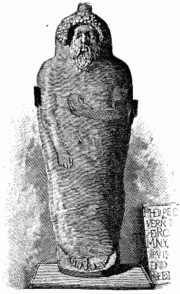
The coastal plain of Lebanon is the historic home of a string of coastal trading cities of Semitic culture, which the Greeks termed Phoenicia, whose maritime culture flourished there for more than 2000 years (c. 2700 B.C.E.– 450 B.C.E.). Ancient ruins in Byblos, Berytus (Beirut), Sidon, Sarepta, and Tyre show a civilized nation, with urban centres and sophisticated arts. The territory was a cosmopolitan centre for many nations and cultures. Its people roamed the Mediterranean seas, skilled in trade and in art, and founded trading colonies. They were also the creators of the oldest known 24-letter alphabet, a shortening of earlier 30-letter alphabets such as Proto-Sinaitic and Ugaritic.
Phoenicia maintained an uneasy tributary relationship with the neo-Assyrian and neo-Babylonian empires. Cyrus the Great conquered Phoenicia in 539 B.C.E. Phoenicia was divided into four vassal kingdoms by the Persians: Sidon, Tyre, Arwad, and Byblos, and prospered, furnishing fleets for the Persian kings.
Greeks and Romans
It was added to the empire of Alexander the Great, who notably conquered Tyre (332 B.C.E.) by extending a still-extant causeway from the mainland in a seven-month effort. It fell to the Seleucid Empire (323 B.C.E. to 60 B.C.E.) after Alexander's death. The area was conquered by the Roman Empire in the first century B.C.E., was dominated by the Byzantine, then the Greek-speaking Roman Empire centered around its capital of Constantinople (306 C.E. – 1095 C.E.). Christianity was introduced to Phoenicia from neighboring Galilee soon after the time of Jesus of Nazareth.
Arab rule and the Middle Ages
The Arab advances brought Islam soon after the death of Islam's Prophet Muhammad. Muslim influence increased greatly in the seventh century when the Umayyad capital was established at nearby Damascus. During the Middle Ages, Lebanon was heavily involved in the Crusades. Lebanon was in the main path of the First Crusade's advance on Jerusalem. Later, Frankish nobles occupied present-day Lebanon as part of the southeastern Crusader States. The southern half of present-day Lebanon formed the northern march of the Kingdom of Jerusalem; the northern half was the heartland of the County of Tripoli. Although Saladin eliminated Christian control of the Holy Land around 1190, the Crusader states in Lebanon and Syria were better defended.
Mamluks and Ottomans
Muslim control of Lebanon was re-established in the late 13th century under the Mamluk sultans of Egypt. Lebanon was later contested between Muslim rulers until the Ottoman Empire solidified authority over the eastern Mediterranean. Ottoman control was uncontested during the early modern period, but the Lebanese coast became important for its contacts and trades with Venice and other Italian city-states. Lebanon was part of the Ottoman Empire for over 400 years, in a region known as Greater Syria, until 1916
The mountainous territory of Mount Lebanon has long been a shelter for minority and persecuted groups, including its historic Maronite Christian majority along with Druze, and local Shi'a Muslims. It was an autonomous Maronite region of the Ottoman empire.
French mandate
The area became a part of the French Mandate of Syria following World War I. On September 1, 1920, France formed the State of Greater Lebanon as one of several ethnic enclaves within Syria. Lebanon was a largely Christian (mainly Maronite) enclave but also included areas containing many Muslims and Druzes. On September 1, 1926, France formed the Lebanese Republic. The Republic was afterward a separate entity from Syria but still administered under the French Mandate for Syria.
World War II
The Vichy authorities in 1941 allowed Germany to move aircraft and supplies through Syria to Iraq where they were used against British forces. The United Kingdom, fearing that Nazi Germany would gain full control of Lebanon and Syria by pressure on the weak Vichy government, sent its army into Syria and Lebanon.
Independence
After the fighting ended in Lebanon, General Charles de Gaulle visited the area. Under various political pressures from both inside and outside Lebanon, de Gaulle decided to recognize the independence of Lebanon. On 26 November 1941 General Georges Catroux announced that Lebanon would become independent under the authority of the Free French government. Elections were held in 1943 and on November 8, 1943 the new Lebanese government unilaterally abolished the mandate. The French reacted by throwing the new government into prison. In the face of international pressure, the French released the government officials on November 22, 1943, and accepted the independence of Lebanon.
The allies kept the region under control until the end of World War II. The last French troops withdrew in 1946. Lebanon's unwritten National Pact of 1943 required that its president be Christian and its prime minister be Muslim.
Lebanon's history since independence has been marked by alternating periods of political stability and turmoil (including a civil conflict in 1958) interspersed with prosperity built on Beirut's position as a regional center for finance and trade.
1948 Arab-Israeli war
Attacks 15 May–10 June, 1948. Five years after gaining independence, Lebanon joined its fellow Arab states and invaded Israel during the 1948 Arab-Israeli War. It took over logistical support of the Arab Liberation Army after it found itself cut off from its bases in Syria while attempting an attack on the newly-proclaimed Jewish State. After the defeat of the Arab Liberation Army in Operation Hiram, Lebanon accepted an armistice with Israel on March 23, 1949. Approximately 100,000 Palestinian refugees were living in Lebanon in 1949 as a result of the creation of Israel and the subsequent war. The Lebanese-Israeli border remained closed, but quiet, until after the Six Day War in 1967.
Civil war
In 1975, civil war broke out in Lebanon. The Lebanese Civil War lasted 15 years, devastating the country's economy, and resulting in the massive loss of human life and property. It is estimated that 150,000 people were killed and another 200,000 maimed. The war ended in 1990 with the signing of the Taif Agreement and parts of Lebanon were left in ruins.
During the civil war, Lebanon was twice invaded and occupied by the Israel Defense Forces (IDF) in 1978 and 1982. Israel remained in control of Southern Lebanon until 2000, when there was a general decision, led by Israeli Prime Minister Ehud Barak, to withdraw due to continuous guerrilla attacks executed by Hezbollah militants and a belief that Hezbollah activity would diminish and dissolve without the Israeli presence. The UN determined that the withdrawal of Israeli troops beyond the blue line was in accordance with UN Security Council Resolution 425, although a border region called the Shebaa Farms is still disputed. Hezbollah declared that it would not stop its operations against Israel until this area was liberated.
After the end of the civil war, Lebanon saw a period of relative calm until the 2006 Lebanon War.
Assassinations
On February 14, 2005, former Prime Minister Rafik Hariri was assassinated in a car bomb explosion. Leaders of the March 14 Alliance accused Syria of the attack, due to its extensive military and intelligence presence in Lebanon, and the public rift between Hariri and Damascus over the Syrian-backed constitutional amendment extending pro-Syrian President Lahoud's term in office. Syria denied any involvement. Others, namely the Forces of March 8 and Syrian officials, claimed that the assassination may have been executed by the American CIA or the Israeli Mossad in an attempt to destabilize the country. The Hariri assassination marked the beginning of a series of assassination attempts that led to the loss of a number of prominent Lebanese figures.
Investigation
The United Nations Security Council unanimously adopted Resolution 1595 on April 7, 2005, which called for an investigation into the assassination of Rafik Hariri. The findings of the investigation were officially published on October 20, 2005 in the Mehlis report. The report suggested the assassination was carried out by a group with considerable resources, that it had been prepared many months in advance, and that the group had detailed knowledge of Hariri’s movements.
The vehicle used for the explosion was a Mitsubishi Fuso Canter stolen in Japan, and was most likely detonated by a suicide bomber. The United Nations Security Council and the Lebanese cabinet have approved a Special Tribunal for Lebanon that would prosecute those responsible for Hariri's death.
Cedar Revolution
The Cedar Revolution was a chain of demonstrations and popular civic action, especially in Beirut, triggered by the assassination of former |Lebanese Prime Minister Rafik Hariri on February 14, 2005.
On February 28, 2005, with over 50,000 people demonstrating in Martyrs' Square, Prime Minister Omar Karami and his Cabinet resigned. In response, Hezbollah organized a large counter-demonstration attended by hundreds of thousands of people, which was staged on March 8 in Beirut, supporting Syria and accusing Israel and the United States of meddling in internal Lebanese affairs.
On March 14, 2005, one month after Hariri's assassination, throngs of people rallied in Martyrs' Square in Lebanon with around one million people. Protesters marched demanding the truth about Hariri's murder and independence from Syrian presence in Lebanon. The march reiterated their desire for a sovereign, democratic, and unified country, free of Syria's hegemony.
In the weeks following the demonstrations, bombs were detonated in Christian areas near Beirut. Although the damage was mostly material, these acts threatened to drag Lebanon back into sectarian strife.
Eventually, and under pressure from the international community, Syria began withdrawing its 15,000-strong army troops from Lebanon. By April 26, 2005, all uniformed Syrian soldiers had already crossed the border back to Syria. On April 27, 2005, the Lebanese celebrated their first free-from-Syria day. UN forces were sent to Lebanon to verify the military withdrawal.
Elections
During the first parliamentary elections held after Syria's withdrawal from Lebanon in May 2005, the anti-Syrian coalition of Sunni Muslim, Druze and Christian parties led by Saad Hariri, son of assassinated ex-Prime Minister Rafik Hariri, won a majority of seats in the new Parliament. The Free Patriotic Movement (FPM), though not allied with the Rafik Hariri Martyr List during the elections, garnered strong representation in the newly elected Parliament.
The anti-Syrian coalition did not win the two-thirds majority required to force the resignation of Syrian-appointed President Lahoud voted for by Rafik Hariri parliamentary bloc, due to the unexpectedly strong showing of formerly exiled General Michel Aoun's Free Patriotic Movement party in Mount Lebanon.
After the elections, Hariri's Future Movement party, the country's dominant political force, nominated Fouad Siniora, a former Finance Minister, to be Prime Minister. On July 18, 2005, Lebanon elected a new parliament dominated by an anti-Syrian coalition. This parliament approved a motion to free Samir Geagea, leader of the Christian Lebanese Forces, who had spent most of the past 11 years in solitary confinement in an underground cell with no access to news. The motion was endorsed by pro-Syrian Lebanese President Émile Lahoud the next day.
2006 Lebanon War
The conflict began with a cross-border Hezbollah raid and shelling of Israel, which resulted in the capture of two and killing of eight Israeli soldiers. Israel held the Lebanese government responsible for the attack, as it was carried out from Lebanese territory, and initiated an air and naval blockade, airstrikes across much of the country on July 12, 2006,, and ground incursions into southern Lebanon. The fighting quickly escalated into 33 days of "open war" and ultimately led to the death of 1191 Lebanese and 44 Israeli civilians.
Fighting came to end on August 14, three days after UN Security Council Resolution 1701—which called for an immediate cessation of hostilities—was passed. Israel, however, maintained a naval and aerial blockade on Lebanon in a measure meant to prevent Hezbollah from smuggling arms. The blockade was lifted on September 8, and by early December, all Israeli troops had withdrawn from Lebanon.
Government and politics
The Lebanese Republic has a parliamentary democracy in which the highest offices are proportionately reserved for representatives from certain religious communities to minimise sectarian conflict – an overall framework known as “confessionalism”.
The chief of state is the president, who is elected by the National Assembly for a six-year term, and who may not serve consecutive terms. The head of government is the prime minister, who, with the deputy prime minister, is appointed by the president in consultation with the National Assembly. The cabinet chosen by the prime minister in consultation with the president and members of the National Assembly. By agreement, the president is a Maronite Christian, the prime minister is a Sunni Muslim, and the speaker of the National Assembly is a Shi'a Muslim. The last presidential election was held in 1998. In September 2004 the National Assembly voted 96 to 29 to extend Emile LAHUD's six-year term by three years.
The legislature, the unicameral National Assembly or Majlis Alnuwab (Arabic) or Assemblee Nationale (French) has 128 seats. Members elected by popular vote on the basis of sectarian proportional representation (divided in half between Muslims and Christians) to serve four-year terms. Those 21 years of age and over have the right to vote. This is compulsory for all males, and authorized for women at age 21 with elementary education.
The judiciary comprises four Courts of Cassation (three courts for civil and commercial cases and one court for criminal cases), a Constitutional Council (called for in Ta'if Accord) which rules on the constitutionality of laws, and a Supreme Council, which hears charges against the president and prime minister as needed. Juries are not used in trials. The legal system is a mixture of Ottoman law, canon law, Napoleonic code, and civil law. There is no judicial review of legislative acts, and Lebanon has not accepted compulsory International Court of Justice jurisdiction.
There are religious courts that have jurisdiction on matters such as marriage, divorce, and inheritance. Lebanese law does not provide for civil marriage (although it recognizes such marriages contracted abroad). Lebanon also has military courts that have jurisdiction over civilians for crimes of espionage, treason, and other crimes that are considered to be security-related. These military courts have been criticized by human rights organizations such as Amnesty International for "seriously fall[ing] short of international standards for fair trial" and having "very wide jurisdiction over civilians".
Lebanon is divided into six governorates that are further subdivided into 25 districts. The districts themselves are also divided into several municipalities, each enclosing a group of cities or villages.
Lebanon’s sovereignty has been compromised by civil war, foreign occupations, and the activity of terrorist groups. From the mid-1970s until the parliamentary elections in 1992, civil war precluded the exercise of political rights. Syria occupied the greater part of the country from the time of the second Lebanese civil war (which began in 1975) until 2005 and Israel occupied parts of it from 1978 to 2000.
Sectarian politics
Religion has traditionally been of overriding importance in defining the Lebanese population. Dividing state power between the religious sects, and granting religious authorities judicial power, dates back to Ottoman times (the millet system). The practice was reinforced during French colonialism, when Christian groups were granted privileges. This system of government, while partly intended as a compromise between sectarian demands, has caused tensions that still dominate Lebanese politics to this day. The Christian population majority is believed to have ended in the early 1930s, but government leaders would agree to no change in the political power balance. This led to Muslim demands of increased representation, and the constant sectarian tension slid into violent conflict in 1958 (prompting U.S. intervention) and again in the grueling Lebanese Civil War, in 1975-90.
The balance of power has been slightly adjusted in the 1943 National Pact, an informal agreement struck at independence, in which positions of power were divided according to the 1932 census. The Sunni elite was then accorded more power, but Maronites continued to dominate the system. The sectarian balance was again adjusted towards the Muslim side - but simultaneously further reinforced and legitimized . Shi'a Muslims (by now the largest sect) then gained additional representation in the state apparatus, and the obligatory Christian-Muslim representation in Parliament was downgraded from a 6:5 to a 1:1 proportion. Christians of various sects were then generally thought to constitute about 40% of the population, although often Muslim leaders would cite lower numbers, and some Christians would claim that they still held a majority of the population.
Hezbollah
Hezbollah, literally "party of God", is a Shi'a Islamic political and paramilitary organization based in Lebanon. It follows a distinct version of Islamist Shi'a ideology developed by Ayatollah Ruhollah Khomeini, leader of the Islamic Revolution in Iran. Hezbollah began to take shape during the Lebanese Civil War with three main goals comprising the eradication of what it viewed as Western colonialism in Lebanon, the bringing to justice of those who committed atrocities during the war (specifically the Phalangists), and to establishing an Islamic government in Lebanon. Hezbollah has realized that the goal of transforming Lebanon into an Islamic state is not practical at this time and has temporarily abandoned it. The weakness of central government has enabled Hezbollah to become the defacto government of regions under its control.
Economy
Lebanon’s role in the region was shaped by trade, since the area served as a link between the Mediterranean world and India and East Asia. The merchants of the region exported oil, grain, textiles, metal work, and pottery through the port cities to Western markets. The linkage role of Lebanon was further enhanced by the nomads of the Syrian and Arabian deserts who visited the cities of Syria to trade. The caravans developed limited routes that often led to the coastal cities of Tripoli, Beirut, Sidon, or Tyre.
The 1975-90 civil war seriously damaged Lebanon's economic infrastructure, cut national output by half, and all but ended Lebanon's position as a Middle Eastern entrepot and banking hub.
In the years since, Lebanon has rebuilt much of its war-torn physical and financial infrastructure by borrowing heavily - mostly from domestic banks. In an attempt to reduce the ballooning national debt, the Rafiq HARIRI government began an austerity program, reining in government expenditures, increasing revenue collection, and privatizing state enterprises, but economic and financial reform initiatives stalled and public debt continued to grow despite receipt of more than $2-billion in bilateral assistance at the Paris II Donors Conference.
Lebanon has a competitive and free market regime and a strong laissez-faire commercial tradition. Private property is common and encouraged, while the government owns most public services. Land laws resemble those in France and the United States.The Lebanese economy is service-oriented; main growth sectors include banking and tourism. There are no restrictions on foreign exchange or capital movement, and bank secrecy is strictly enforced. Lebanon has recently adopted a law to combat money laundering. There are practically no restrictions on foreign investment. There are no country-specific U.S. trade sanctions against Lebanon.
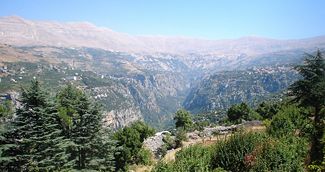
A combination of beautiful climate, many historic landmarks and World Heritage Sites attracts large numbers of tourists to Lebanon annually, in spite of its political instability. In addition, Lebanon's strict financial secrecy and capitalist economy—unique in its area—have given it significant economic status among Arab countries. The thriving tourism and banking activities have naturally made the services sector the most important pillar of the Lebanese economy. The majority of the Lebanese workforce (nearly 65 percent) have preferred employment in the services sector, as a result of the abundant job opportunities and large pay checks. This sector contributes roughly 67.3 percent of the annual Lebanese GDP.
Lebanon is suited for agriculture as it has available water and fertile soil, and possesses the highest proportion of cultivable land in the Arab world. But agriculture attracts 12 percent of the total workforce, and contributes approximately 11.7 percent of the country's GDP.
Lebanon's lack of raw materials for industry and its complete dependence on Arab countries for oil have made it difficult for the Lebanese to engage in significant industrial activity. As such, industry in Lebanon is mainly limited to small businesses concerned with reassembling and packaging imported parts. In 2004, industry ranked second in workforce, with 26 percent of the Lebanese working population, and second in GDP contribution, with 21 percent of Lebanon's GDP.
The Israeli-Hizballah conflict caused an estimated $3.6-billion in infrastructure damage in July and August 2006, and internal Lebanese political tension continues to hamper economic activity.
Exports totalled $1.881-billion in 2005. Export commodities included authentic jewelry, inorganic chemicals, miscellaneous consumer goods, fruit, tobacco, construction minerals, electric power machinery and switchgear, textile fibers, and paper. Export partners were Syria 25.3 percent, United Arab Emirates 11.4 percent, Switzerland 8.1 percent, Turkey 6 percent, and Saudi Arabia 5.4 percent.
Imports totalled $9.34-billion. Import commodities included petroleum products, cars, medicinal products, clothing, meat and live animals, consumer goods, paper, textile fabrics, and tobacco. Import partners were Italy 11.1 percent, Syria 10.7 percent, France 9.2 percent, Germany 6.4 percent, China 5.4 percent, US 5.3 percent, UK 4.4 percent, and Saudi Arabia 4.3 percent.
Per capita GDP was $6681 in 2006, giving Lebanon a rank of 90 on a list of 181 countries. The unemployment rate was 20 percent in 2006, and 28 percent of the population was estimated to exist below the poverty line in 1999.
Demographics
The number of those inhabiting Lebanon proper was estimated at 3,874,050 in July 2006. About 91 percent of the population of Lebanon is urban and comprises many different ethnic groups and religions, including numerous Christian and Muslim sects. Without accurate figures, it is estimated that there are between five and 15 million people of Lebanese descent spread all over the world, Brazil being the country with the biggest Lebanese community abroad. Argentina, Australia, Canada, Colombia, France, Great Britain, Mexico, Venezuela and the USA also have large Lebanese communities. A total of 394,532 Palestinian refugees have registered in Lebanon with the United Nations Relief and Works Agency. Life expectancy for the whole population was 72.63 years in 2005.
Ethnicity
The country encompasses a great mix of cultures and ethnic groups that have been building up for more than 6000 years. Although Arabic, the Arabs only reached Lebanon in the seventh century, and their culture was superimposed on an already diverse ethnic population. Some Lebanese, especially among Maronite Christians, see themselves as descendants of the Phoenicians, Canaanites, Mardaites, and Syriacs. This was supported by genetic studies and tend to de-emphasize or deny Lebanon's Arab heritage. Melkite Greek Catholics, the Greek Orthodox, and some Maronites tend to focus more on the Greek heritage of the region from the days of the Byzantine Empire, and the fact that Greek was maintained as a liturgical language until recently. Some Christians even claim partial descent from Crusader knights who ruled Lebanon for a couple of centuries during the Middle Ages. This identification with non-Arab civilizations also exists in other religious communities, albeit not to the same extent. Sunni and Alawite Muslim, as well as Greek Orthodox and rural Roman Catholic Christians are believed to be of a mixed Levantine (Syrian/Shami) origin.
Lebanese Armenians, Assyrians, Jews, Kurds and Persians form more distinct ethnic minorities, all of them in possession of a national home area outside of Lebanon. However, they total less than four percent of the population.
A total of 402,582 Palestinian refugees were registered in Lebanon with the United Nations Relief and Works Agency (UNRWA) in March 2005, almost all refugees or descendants of refugees from the 1948 Arab-Israeli War. Some may have emigrated during the civil war. There are also a number of Palestinians who are not registered as UNRWA refugees, because they left earlier than 1948 or were not in need of material assistance. The exact number of Palestinians remains a subject of great dispute and the Lebanese government will not provide an estimate. Their presence is controversial, and resisted by large segments of the Christian population, who argue that the primarily Sunni Muslim Palestinians dilute Christian numbers. Many Shi'a Muslims also look unfavorably upon the Palestinian presence, since the camps have tended to be concentrated in their home areas. As a result, Palestinians are not accorded the legal rights enjoyed by the rest of the population, are denied citizenship, and confined to severely overcrowded refugee camps , in which construction rights are severely constricted. Palestinians can't work in a large number of professions, such as lawyers, doctors. Their primary sources of income are UNRWA aid and menial labor sought in competition with Syrian guest workers. The Palestinians are mostly Sunni Muslim, but there is also a Christian minority of over 10 percent (primarily Greek Orthodox).
Lebanon holds a large number of Syrian workers, most of whom are employed on a seasonal basis and do not hold citizenship. They entered Lebanon mainly after Syria established its controversial occupation there during the Lebanese Civil War. They are employed in menial labor, working in areas such as construction. Their exact numbers are disputed, with right-wing Lebanese nationalists tending to give high estimates (up to 1.5 million) while others go as low as 300,000. In 1994, Lebanese authorities - then under Syrian domination - authorized a controversial granting of citizenship to Syrians (and a small number of Palestinians and others) in Lebanon. The precise number is disputed, figures ranging from a 100,000 people to half a million. It seems clear, however, that the act shifted the religious balance in Lebanon in favor of Sunni Muslims, and had important effects on the sectarian makeup of Lebanese politics. The Syrians in Lebanon are Arab, and are mainly Muslims of the Sunni sect.
There are substantial numbers of immigrants from other Arab countries, from Indonesia, the Philippines and Malaysia, as well as smaller numbers of other immigrant minorities. Most of these are employed as guest workers. There are approximately 180,000 stateless persons in Lebanon. Many of these are Kurds from Turkey and Syria, or other Syrians.
Religion
Because the matter of religious balance is a sensitive political issue, a national census has not been conducted since 1932, before the founding of the modern Lebanese state. Consequently there is an absence of accurate data on the relative percentages of the population of the major religions and groups. It is estimated that about 40 percent are Christians (mostly Maronites, Greek Orthodox, Armenian Apostolic, Melkite Greek Catholics, Assyrian Church of the East, Chaldean Catholic), 35 percent are Shia Muslims, 21 percent are Sunni Muslims and five percent are Druze. A small minority of Jews live in central Beirut, Byblos, and Bhamdoun. Lebanon has a population of Kurds (also known as Mhallami or Mardinli), of whom are converted Syriacs estimated to be between 75,000 and 100,000 and considered to be part of the Sunni population.
The Lebanese Constitution acknowledges 18 religious groups. These have the right to handle family law according to their own courts and traditions, and they are the basic players in Lebanon's complex sectarian politics. These groups are not internally homogeneous. For example, the Maronite, Shi'a and Druze communities have been wracked by internal fighting even in recent times. The 18 groups are:
Alawite, Armenian Catholic, Armenian Orthodox (Gregorian), Assyrian Church of the East, Chaldean Catholic, Copt, Druze, Evangelical Christian (including Protestant groups such as Baptists and Seventh-day Adventists), Greek Catholic (Melkite), Greek Orthodox, Isma'ili (Sevener Shi'a), Jewish, Maronite (Maronite Catholic), Roman Catholic (Latins), Twelver Shi'a, Sunni, Syriac Catholic, and Syriac Orthodox.
Language
Languages spoken include Arabic, French, English, and Armenian. Arabic is the official language Lebanon. French, too, is widely spoken and was an official language during the French mandate (which lasted until 1943). Spoken Lebanese is quite different from the standard written Arabic language that is taught in schools along with the other foreign languages. Lebanese Arabic is considered one of the Levantine dialects of Arabic. English became popular, especially among university students, as a second or sometimes third language. Armenian is the native tongue of the Armenian Lebanese in Lebanon.
Men and women
Women may vote, work, attend school, and participate in all forms of public life, but they tend to occupy traditionally female jobs such as secretaries and schoolteachers. More women stay at home than men.Men hold higher social status than women, mainly because of the influence of patriarchal religions. Family is still stressed, as is the woman's role as a nurturing mother.
Marriage and the family
Arranged marriages are rare. Financial pressure has made money, a secure job, and a home important to consider upon entering marriage. Polygamy is legal among Muslims, but it holds a social stigma. Divorce is easy for Muslims, harder for Orthodox Christians, and most difficult in Maronite communities. The divorce rate remains low. Most household units are made up of a nuclear family, although the extended family is important and provides a form of social security. The husband and wife share authority, although wives have more say over children and in various household matters. Religious courts favor male heirs. Land is the most important inheritance in rural areas, while apartments, money, and privately owned shops constitute the bulk of inheritance in the cities. After the family, a person's loyalty is usually with his or her religion, although marriage between members of different religious groups has become frequent. At the end of the twentieth century there was a push to legalize civil marriages.
Kindergartens and babysitters have become more common as more women work outside the home. Grandparents or members of the extended family will help care for a baby. Education is important. Many parents choose expensive religious private schools, for their children to receive moral guidance. Children are encouraged to learn and to be quiet. Parents are strict.
Education
All Lebanese schools are required by the government to follow a prescribed curriculum. The main subjects taught are mathematics, sciences, history, civics, geography, Arabic, French, and English, as well as physical education, art, and at times library use. The subjects gradually increase in difficulty and in number. Students in Grade 11, for example, usually study up to 18 different subjects.
Students go through three academic phases: Elementary education for six years, intermediate for three years, and secondary education for three years. Intermediate pupils may earn a Brevet, and high school students who pass exams earn a baccalaureate certificate. These three phases are provided free to all students and the first eight years are, by law, compulsory. Nevertheless, this requirement is not fully enforced.
After high school, Lebanese students may choose to study at a university, a college, or a vocational training institute. The number of years to complete each program varies. Lebanon has 41 nationally accredited universities, several of which are internationally recognized
While the Lebanese educational system offers a very high quality and international class of education, the local employment market lacks enough opportunities, thus encouraging many of the young educated to travel abroad. You can find successful Lebanese engineers, doctors, businessmen, etc. practically all over the world. When compared to the rest of the Middle East, Lebanese society as a whole is well educated, and as of 2003, 87.4 percent of the population was literate
Class
Money is the most important factor in determining class lines. The middle class lost wealth during the war, and the gap between the rich upper class and the lower class widened. Differences in wealth and status often occur along religious and family lines.
Culture
Overview
The area including modern Lebanon has been for thousands of years a melting pot of various civilizations and cultures. Originally home to the Phoenicians, and then subsequently conquered and occupied by the Assyrians, the Persians, the Greeks, the Romans, the Arabs, the Ottoman Turks and most recently the French, Lebanese culture has over the millennia evolved by borrowing from all of these groups. Lebanon's diverse population, composed of different ethnic and religious groups, has further contributed to the country's lively festivals, highly successful musical styles and literature as well as their rich cuisine - and numerous violent clashes amongst different religious and ethnic groups. When compared to the rest of the Middle East, Lebanese society as a whole is well educated, and as of 2003 87.4% of the population was literate.[2] Lebanese society is very modern and similar to certain cultures of Mediterranean Europe. Not only is Lebanon a distinctive fusion of Christian and Muslim traditions unequaled in the rest of the region, it also serves as the European gateway to the Middle East as well as the Arab gateway to the Western World.[3]
Cuisine
The Lebanese cuisine combines the sophistication of European cuisines with the exotic ingredients of the Middle East.[4] Some of the most popular local dishes include Kibbeh—a lamb-and-cracked-wheat dish, often grilled or fried—and Tabbouleh, a salad made with cracked wheat, finely chopped parsley, tomato, onions and olive oil.[5] The Lebanese also enjoy eating food from many different regions;[5] fast food has also gained widespread popularity, especially among the Lebanese youth.
Arts and literature
In literature, Gibran Khalil Gibran is known to be one of the world's famous writers, particularly known for his book The Prophet, which has been translated into more than twenty different languages.[6]
In art, Moustapha Farroukh and Alfred Bassbouss are very famous. Charles Khoury is also a very known artist, and he has been awarded many national and international prizes.
Festivals
Several international festivals are held in Lebanon, featuring world-renowned artists and drawing crowds from Lebanon and abroad. Among the most famous are the summer festivals at Baalbek, Beiteddine, and Byblos. Beirut in particular has a very vibrant arts scene, with numerous performances, exhibits, fashion shows, and concerts held throughout the year in its galleries, museums, theatres, and public spaces.
ReferencesISBN links support NWE through referral fees
- ↑ Cite error: Invalid
<ref>tag; no text was provided for refs namedname-origin - ↑ Lebanon CIA World Fact Book. [1]. December 18, 2006.
- ↑ Lebanon Culture. [2]. December 18, 2006.
- ↑ Joe George. "Lebanon: The Jewel of the Middle East". Retrieved December 3, 2006.
- ↑ 5.0 5.1 Microsoft Encarta Premium 2006. Customs of Lebanon.
- ↑ The Hindu (January 5, 2003). "Called by life";. Retrieved January 8, 2007.
- Fisk, Robert. Pity the Nation: The Abduction of Lebanon. New York: Nation Books, 2002.
- Holst, Sanford. Phoenicians: Lebanon's Epic Heritage. Los Angeles: Cambridge and Boston Press, 2005.
- Norton, Augustus R. Amal and the Shi'a: Struggle for the Soul of Lebanon. Austin and London: University of Texas Press, 1987.
- Riley-Smith, Jonathan. The Oxford Illustrated History of the Crusades. New York: Oxford University Press, 2001.
- Salibi, Kamal. A House of Many Mansions: The History of Lebanon Reconsidered. Berkeley: University of California Press, 1990.
- Abe F. March: author of To Beirut and Back - An American in the Middle East (ISBN 1-4241-3853-1) recounts the years shortly before and including the beginning of the Lebanese Civil War (1975-1990). He is also listed as an Expert on Israeli-Palestinian ProCon.org
External links
- Government
- The Lebanese Governmental Portal for Information & Forms
- Official site of the President of the Lebanese Republic
- Official site of The Lebanese Parliament (Arabic)(French)
- Central Administration for Statistics
- Ministry of Tourism
- Internal Security Forces
- The Lebanese Armed Forces
- General-security.gov.lb
- Lebanon Customs site
- Central Bank of Lebanon
- Beirut Stock Exchange
- Embassy of Lebanon, Washington, D.C.
- News
- AnNahar newspaper (Arabic)
- As-Safir newspaper (Arabic)
- Al-Akhbar newspaper (Arabic)
- L'Orient-Le Jour (Lebanese daily newspaper in French) (French)
- LBC
- Future TV
- United Nations - Mehlis Report official report of the investigation into Rafiq al-Hariri's assassination
- Ya Libnan - Lebanon News, Videos and Photos (Lebanese daily news in English) (English)
- Culture and education
- UNESCO World Heritage Sites in Lebanon
- Al-Bustan Festival, Beit Meri
- Baalbek Festival
- Beiteddine Festival
- Byblos Festival
- Lebanese Cultural Journal
- The National Museum of Beirut
- General information
- Lebanon at the The World Factbook
- US State Department - Lebanon includes Background Notes, Country Study and major reports
- LibanVote (comprehensive electoral database)
Credits
New World Encyclopedia writers and editors rewrote and completed the Wikipedia article in accordance with New World Encyclopedia standards. This article abides by terms of the Creative Commons CC-by-sa 3.0 License (CC-by-sa), which may be used and disseminated with proper attribution. Credit is due under the terms of this license that can reference both the New World Encyclopedia contributors and the selfless volunteer contributors of the Wikimedia Foundation. To cite this article click here for a list of acceptable citing formats.The history of earlier contributions by wikipedians is accessible to researchers here:
The history of this article since it was imported to New World Encyclopedia:
Note: Some restrictions may apply to use of individual images which are separately licensed.


